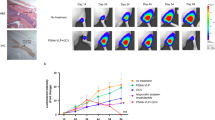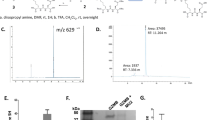Abstract
This study was designed to investigate the prostate cancer-specific tumoricidal effect of the suicide gene, Escherichia coli uracil phosphoribosyltransferase (UPRT), driven by the human prostate-specific membrane antigen promoter/enhancer (PSMAE/P) in vitro. When transfected with PSMAE/P-EGFP (enhanced green fluorescence protein) (a plasmid construct with the green fluorescence protein gene driven by the PSMAE/P), only the androgen-responsive and PSMA-positive prostate cancer cell line, LNCaP, expressed GFP, indicating the specificity of the PSMAE/P activity in androgen-sensitive and PSMA-positive prostate cancer cells. Taking advantage of this prostate cancer-specific property of PSMAE/P, we successfully introduced bacterial UPRT into LNCaP cells where the tumoricidal effect of 5-fluorouracil (5-FU) was significantly increased when compared with the cells without the exogenous UPRT. We conclude that the efficacy of 5-FU-based chemotherapy in prostate cancers can be significantly improved by targeted expression of the suicide gene UPRT under the control of PSMAE/P.
This is a preview of subscription content, access via your institution
Access options
Subscribe to this journal
Receive 4 print issues and online access
$259.00 per year
only $64.75 per issue
Buy this article
- Purchase on Springer Link
- Instant access to full article PDF
Prices may be subject to local taxes which are calculated during checkout



Similar content being viewed by others
References
Chodak G, Keane T, Klotz L . Critical evaluation of hormonal therapy for carcinoma of the prostate. Urology 2002; 60: 201–208.
Huggins C, Hodges C . Studies on prostatic cancer. I. The effect of castration, of estrogen and androgen injection on serum phosphatases in metastatic carcinoma of the prostate. Cancer Res 1941; 1: 293–297.
Harzstark A, Ryan C . Novel therapeutic strategies in development for prostate cancer. Expert Opin Investig Drugs 2008; 17: 13–22.
Hadaschik B, Gleave M . Therapeutic options for hormone-refractory prostate cancer in 2007. Urol Oncol 2007; 25: 413–419.
Mike S, Harrison C, Coles B, Staffurth J, Wilt T, Mason M . Chemotherapy for hormone-refractory prostate cancer. Cochrane Database Syst Rev 2006; 4: CD005247.
Swanson G, Faulkner J, Smalley S, Noble M, Stephens R, O’Rourke T et al. Locally advanced prostate cancer treated with concomitant radiation and 5-fluorouracil: Southwest Oncology Group Study 9024. J Urol 2006; 176: 548–553; discussion 553.
Longley D, Harkin D, Johnston P . 5-fluorouracil: mechanisms of action and clinical strategies. Nat Rev Cancer 2003; 3: 330–338.
Heggie G, Sommadossi J, Cross D, Huster W, Diasio R . Clinical pharmacokinetics of 5-fluorouracil and its metabolites in plasma, urine, and bile. Cancer Res 1987; 47: 2203–2206.
Van Kuilenburg A . Dihydropyrimidine dehydrogenase and the efficacy and toxicity of 5-fluorouracil. Eur J Cancer 2004; 40: 939–950.
Moolten F . Tumor chemosensitivity conferred by inserted herpes thymidine kinase genes: paradigm for a prospective cancer control strategy. Cancer Res 1986; 46: 5276–5281.
Li J, Huang S, Chen J, Yang Z, Fei X, Zheng M et al. Identification and characterization of human uracil phosphoribosyltransferase (UPRTase). J Hum Genet 2007; 52: 415–422.
Kanai F, Kawakami T, Hamada H, Sadata A, Yoshida Y, Tanaka T et al. Adenovirus-mediated transduction of Escherichia coli uracil phosphoribosyltransferase gene sensitizes cancer cells to low concentrations of 5-fluorouracil. Cancer Res 1998; 58: 1946–1951.
Koyama F, Sawada H, Fuji H, Hamada H, Hirao T, Ueno M et al. Adenoviral-mediated transfer of Escherichia coli uracil phosphoribosyltransferase (UPRT) gene to modulate the sensitivity of the human colon cancer cells to 5-fluorouracil. Eur J Cancer 2000; 36: 2403–2410.
Oonuma M, Sunamura M, Motoi F, Fukuyama S, Shimamura H, Yamauchi J et al. Gene therapy for intraperitoneally disseminated pancreatic cancers by Escherichia coli uracil phosphoribosiltransferase (UPRT) gene mediated by restricted replication-competent adenoviral vectors. Int J Cancer 2002; 102: 51–59.
Miyagi T, Koshida K, Hori O, Konaka H, Katoh H, Kitagawa Y et al. Gene therapy for prostate cancer using the cytosine deaminase/uracil phosphoribosyltransferase suicide system. J Gene Med 2003; 5: 30–37.
Ikegami S, Tadakuma T, Ono T, Suzuki S, Yoshimura I, Asano T et al. Treatment efficiency of a suicide gene therapy using prostate-specific membrane antigen promoter/enhancer in a castrated mouse model of prostate cancer. Cancer Sci 2004; 95: 367–370.
Zhao F, Li H, Cheng H, Zeng H, Wei Q, Li X . (Construction and expression of recombinant plasmid with prostate-specific membrane antigen promoter and enhancer regulating uracil phosphoribosyltransferase gene). Sichuan Da Xue Xue Bao Yi Xue Ban 2005; 36: 172–175.
Heidelberger C, Chaudhuri N, Danneberg P, Mooren D, Griesbach L, Duschinsky R et al. Fluorinated pyrimidines, a new class of tumour-inhibitory compounds. Nature 1957; 179: 663–666.
Malet-Martino M, Jolimaitre P, Martino R . The prodrugs of 5-fluorouracil. Curr Med Chem Anticancer Agents 2002; 2: 267–310.
Baccanari D, Davis S, Knick V, Spector T . 5-Ethynyluracil (776C85): a potent modulator of the pharmacokinetics and antitumor efficacy of 5-fluorouracil. Proc Natl Acad Sci USA 1993; 90: 11064–11068.
Naguib F, Hao S, el Kouni M . Potentiation of 5-fluorouracil efficacy by the dihydrouracil dehydrogenase inhibitor, 5-benzyloxybenzyluracil. Cancer Res 1994; 54: 5166–5170.
Schmoll H . Dihydropyrimidine dehydrogenase inhibition as a strategy for the oral administration of 5-fluorouracil: utility in the treatment of advanced colorectal cancer. Anticancer Drugs 2003; 14: 695–702.
Niculescu-Duvaz I, Springer C . Introduction to the background, principles, and state of the art in suicide gene therapy. Mol Biotechnol 2005; 30: 71–88.
O’Keefe D, Uchida A, Bacich D, Watt F, Martorana A, Molloy P et al. Prostate-specific suicide gene therapy using the prostate-specific membrane antigen promoter and enhancer. Prostate 2000; 45: 149–157.
Israeli R, Powell C, Corr J, Fair W, Heston W . Expression of the prostate-specific membrane antigen. Cancer Res 1994; 54: 1807–1811.
Chang SS, Reuter VE, Heston WD, Gaudin PB . Comparison of anti-prostate-specific membrane antigen antibodies and other immunomarkers in metastatic prostate carcinoma. Urology 2001; 57: 1179–1183.
Acknowledgements
We thank Hao Zeng for providing plasmid of pPSMAE/P-EGFP. This study was funded by the Science and Technology Bureau of SiChuan province in China for Scientific Research (04JY029-082-1).
Author information
Authors and Affiliations
Corresponding authors
Rights and permissions
About this article
Cite this article
Zhao, F., Zhang, S., Yu, Z. et al. Specific targeting of prostate cancer cells in vitro by the suicide gene/prodrug system, uracil phosphoribosyltransferase/5-fluorouracil, under the control of prostate-specific membrane antigen promoter/enhancer. Prostate Cancer Prostatic Dis 12, 166–171 (2009). https://doi.org/10.1038/pcan.2008.39
Received:
Revised:
Accepted:
Published:
Issue Date:
DOI: https://doi.org/10.1038/pcan.2008.39
Keywords
This article is cited by
-
Anti-tumor effects of a recombinant anti-prostate specific membrane antigen immunotoxin against prostate cancer cells
BMC Urology (2017)
-
Influence of Androgen Deprivation Therapy on the Uptake of PSMA-Targeted Agents: Emerging Opportunities and Challenges
Nuclear Medicine and Molecular Imaging (2017)
-
Adipose Tissue–derived Mesenchymal Stem Cells Expressing Prodrug-converting Enzyme Inhibit Human Prostate Tumor Growth
Molecular Therapy (2010)



